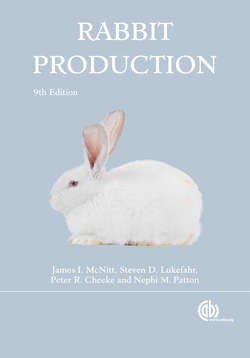Читать книгу Rabbit Production - James I McNitt - Страница 27
На сайте Литреса книга снята с продажи.
3
Rabbit Breeds Selecting a Breed
ОглавлениеThe prospective rabbit raiser should decide on the purpose for which the rabbits will be raised. He or she should then select a breed that will be best suited to this and to his or her personal preferences. No one breed is best for all purposes, but with widely different characteristics among breeds, little difficulty should be encountered in making a selection.
With respect to body conformation, there is considerable variation, from the “racy type” of the Belgian Hare to the compact body shape of the medium weight meat breeds to the large body frame of the giant breeds. Mature weights range from less than 1.1 kg for the Netherland Dwarf to 6.4 kg for the Flemish Giant.
The different breeds range in length of coat from the short-furred Rex to the Angora, which has an annual growth of 20 to 25 cm of wool. There are also many different coat colors, and the rabbits may be solid black, blue, chocolate, fawn, gray, white, etc., or with spots, or of mixed colors.
For commercial meat production, the New Zealand White is the principal breed and variety. It has a number of desirable traits, including a satisfactory growth rate, acceptable carcass quality, good prolificacy, and good mothering ability. In general, it possesses many characteristics desirable for a meat-producing animal. The other major meat breed is the Californian. It tends to finish out at a lighter weight than the New Zealand White but has a higher carcass yield and meat-to-bone ratio. Commercial producers often cross Californian bucks with New Zealand White does to produce a high quality market animal that combines the best qualities of both breeds. Thus, for commercial meat production, the New Zealand White and the Californian are traditionally the rabbits of choice. Other breeds may have potential in certain markets, although careful breed evaluations must be made before they can be widely recommended.
Breeds such as the Champagne D’Argent, Chinchilla, Dutch, Flemish Giant, Palomino, and Satin have been used to a minor extent, either to produce crossbred meat rabbits or as purebreds. Generally, premium market prices are paid for meat rabbits with white fur, so it is inadvisable to produce colored rabbits commercially.
Other types of commercial production include Rex pelts and Angora wool. These are discussed in Chapters 22 and 23, respectively.
For backyard rising of rabbits as pets and for home meat production, the choice of a breed is not critical, as maximum production and profit are not being sought. Personal preferences as to color and type are greater factors. If children are involved, they will probably be more interested in a variety of colors. For strictly pet raising or backyard meat production, there is nothing wrong with indiscriminate crossing. Children may want rabbits of various colors and crosses; this may stimulate their curiosity and result in a lifelong interest in rabbits.
For show purposes, the selection of a breed will be based on personal preferences, availability of good breeding stock, etc. The dwarf breeds require much less feed and space than the medium or giant breeds, which might be a consideration in breed selection.
A significant market sometimes exists for laboratory animals, which are used in biomedical research. Generally, the New Zealand White is used in research, although large numbers of Dutch are also used. The Florida White was developed as a laboratory animal and might be more extensively used if scientists were made aware of its existence. Its feed requirements are considerably less than those of the New Zealand White, which is a significant factor when large numbers of research animals are to be kept for long periods.
